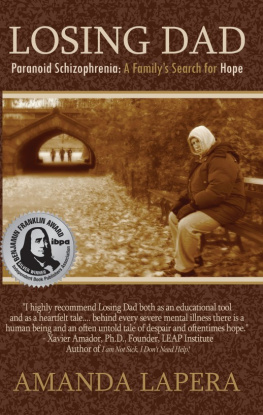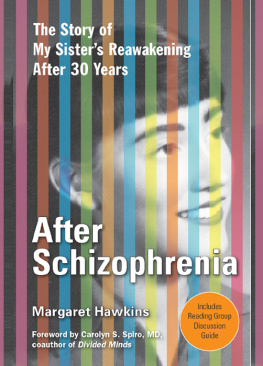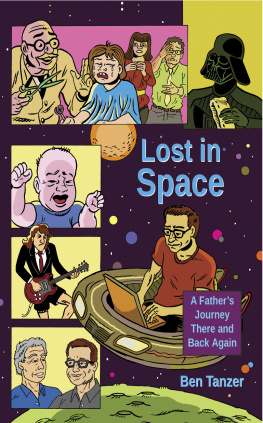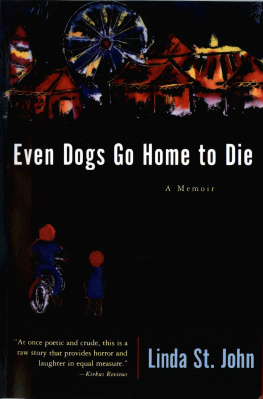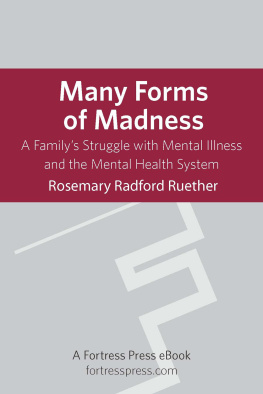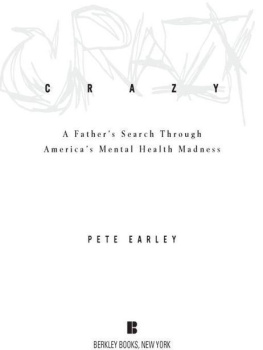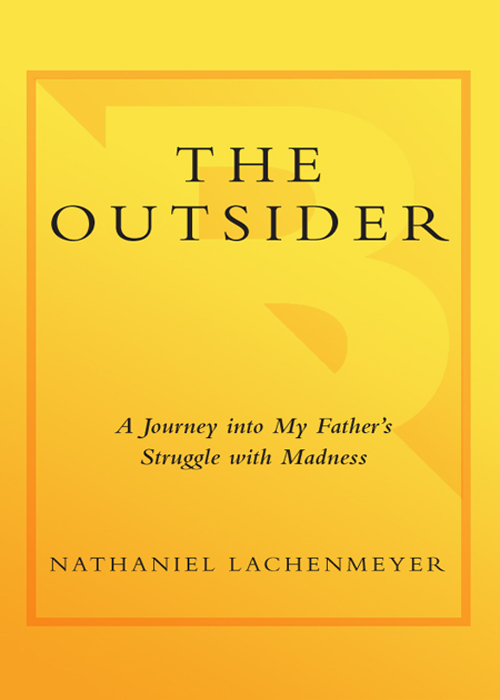
The
Outsider
A Journey
into My
Fathers
Struggle
with
Madness
Nathaniel Lachenmeyer
Broadway Books
New York
Contents
For Charles William Lachenmeyer
19431995
For the multitude of men and women with schizophrenia living on the streets of New York City, who remind me every day that this book is about the present as much as it is about the past.
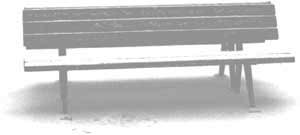
None of us can help the things life has done to us. Theyre done before you realize it, and once theyre done they make you do other things until at last everything comes between you and what youd like to be, and youve lost your true self forever.
Eugene ONeill,
Long Days Journey into Night
Acknowledgments
I would like to thank the following people, whose assistance made this book possible.
The people who agreed to tell me what they remembered about my father
The people who knew him in New York. Clifford Eriksen, Paul Feinstein, Dr. Theodore Kemper, James McKenzie, Dr. John Oldham, Tom Salvator, George Sherman, Herbert Teitelbaum.
The people who knew him in Virginia. Dr. Brian Chabot, Dudley Jensen, Dr. Wayne Kernodle, Dr. Edwin Rhyne, Waldemar Riley, Richard Wolfson, Shomer Zwelling.
The people who knew him in North Carolina. Dr. Richard Cramer, Dr. Satoshi Ito, Dr. Jim Wiggins.
The people who knew him in New Hampshire. Debbie Becker, Sean Chandler, George Comtois, Susan Deane, Diane DiStaso, Dr. Robert Drake, John Englund, Jolyon Johnson, Helena Laware, Kratz Leatherman, Barbara Maloney, Anne Nute, John OMalley, Gail Page, Eleanor Rager, Dr. Edward Rowen, Janet Stiles, Ralph Twombly, Dr. Robert Vidaver.
The people who knew him in Vermont. Corporal Robert Booher, Dr. John Burchard, Mike Cohen, Barbara Collins, Officer Frederick Colvin, Robert Conlon, Kimball Daigneault, Steven Danaher, Jeffrey Degree, Detective Daniel Doherty, Daniel Forsey, Louis Hines, Ruth Hunt, Amy King, John Lapp, Helen Leary, David Lines, John Lines, Henry Mack, John Markey, Mark Martin, James Morgan, Dr. Richard Munson, H. P. Palmer, Jason Palmer, Willis Racht, Allison Sarno, Jerry Schwarz, Gary Sisco, Judge Marilyn Skoaglund, Dr. Sandra Steingard, Officer Kathleen Stubbing, Laura Thompson, Dr. William Woodruff.
The people who helped sustain me during the difficult times
My mother, whose support, encouragement, honesty, and strength are responsible for much of what is good in this book and much of what is good in me. My wife, Christina, whose love, kindness, and generosity have restored my interest in the future. Juliana Bates, whose friendship saved me from seeing my fathers image in death. Georgie, Inside-Outside, Pythias, Damian, Desire, Poa, Mr. Jones, and Stanleywho have taught me that good friends often walk on four legs.
Authors Note
This book is about my father. This book is also about schizophrenia. Approximately 1 percent of the population worldwide suffers from schizophreniaan estimated 2.5 million people in the U.S. alone. More than one hundred thousand new cases are reported here each year. The age of onset, although variable, is generally late adolescence or early adulthood. The diagnosis of schizophrenia involves the recognition of a constellation of signs and symptoms associated with impaired occupational and social functioning. Contrary to popular belief, schizophrenia has nothing to do with multiple personality disorder. Symptoms include: delusions, hallucinations, disorganized speech, grossly disorganized or catatonic behavior, and flattening of affect. Approximately one-third of people with schizophrenia, my father included, suffer from the paranoid subtype, which is distinguished by prominent delusions and/or auditory hallucinations, usually organized around a common theme, without prominent disturbances in cognitive functioning or affect.
Schizophrenia is one of the most chronic and debilitating of all mental illnesses, accounting for more than three thousand deaths per year in the US, 93 percent from suicide. The overall lifetime suicide rate for people with schizophrenia is more than 10 percent; approximately half of people diagnosed with schizophrenia will make a suicide attempt at some point during their lives. Mortality in persons with schizophrenia is two to four times higher than in the general population. Measured in economic terms, the disorder costs the US 32.5 billion dollars annually in direct treatment and support costs, loss of productivity, and caregiver and related services. More than any other human affliction, schizophrenia defines the character of the American city, accountingwith bipolar disorderfor approximately one-third of the homeless population in the US.
As a result of their disorder, people with schizophrenia typically function at a much lower level than they had prior to the onset of symptoms. Many individuals are unable to hold a job for sustained periods of time and are employed at lower levels than their parentsa phenomenon known as downward drift. The majority of individuals with schizophrenia do not marry, and most have relatively limited social contacts. Many have limited or no insight into the fact that they are ill. Most studies suggest that the course the disorder takes is variable from case to case, with some individuals displaying exacerbations and remissions, and others remaining chronically ill. Complete remission is rare.
There are many competing theories about the causes of schizophrenia. There is a general consensus, however, that schizophrenia is a neurobiological disorder; that is, that its causes are primarily biological rather than social in nature. The main methods of treatment for schizophrenia are antipsychotic medications, which act on the neurotransmitters in the brain, complemented with occupational and social skills training and supportive psychotherapy. Although antipsychotic medications have become much more effective in treating some of the symptoms of schizophrenia over the past three decadesin particular, delusions and hallucinationstheir efficacy is not uniform for all people suffering from schizophrenia, and they can be attended by severe side effects. Most people with schizophrenia continue to suffer some symptoms throughout their lives irrespective of the method of treatment. There is no cure for schizophrenia.
Part One
We all leave behind memories as our primary legacy.
Charles Lachenmeyer,
Thought Control and Technological
Slavery in America (?), Issue 1

Chapter 1
The
Transient
I still remember the shock I felt the first time I saw the transient. It was December 1, 1978, the day before my ninth birthday. It was snowing. My father and I were on our annual excursion to a camera store on the West Side of Manhattan that sold Super 8 movies. Each year at my birthday party, after lunch and cake, my father would set up the S-8 movie projector and portable screen in the cramped quarters of his wood-paneled office. With the help of six or seven kids, darkness, and a little imagination, my fathers office acquired the magic of an old movie palace. In one afternoon we would see Charlie Chaplin in The Circus, Bela Lugosi in Dracula
Next page

